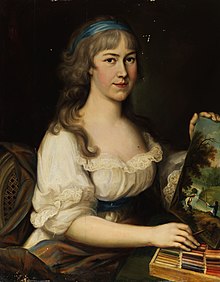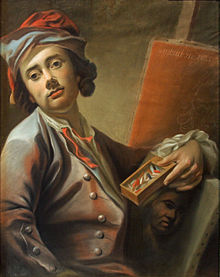Today I started on an experiment with my pastels. On a “Wallis sanded paper” I covered the paper with hot pink, purple, and blue. Next I took a big brush and soaked the paper with Gamsol Turpentine. I was surprised and delighted with the results. The pastels covered the paper like a dye covers fabric, soaking down into the sanded paper.
I will finish the experiment with a floral drawing of Day Lillies using my dry pastels.
You might be curious about what are pastels anyway? Here is some information on pastels from wikipedia.
Pastel media[edit]
Georg Anton Urlaub (1713–1759) holding a box of pastels in his hands. Selfportrait, 1735
Ants Laikmaa Taebla landscape from 1936.
Pastel sticks or crayons consist of pure powdered pigment combined with a binder. The exact composition and characteristics of an individual pastel stick depends on the type of pastel and the type and amount of binder used. It also varies by individual manufacturer.
Dry pastels have historically used binders such as gum arabic and gum tragacanth. Methyl cellulose was introduced as a binder in the twentieth century. Often a chalk or gypsum component is present. They are available in varying degrees of hardness, the softer varieties being wrapped in paper. Some pastel brands use pumice in the binder to abrade the paper and create more tooth.
Dry pastel media can be subdivided as follows:
- Soft pastels: This is the most widely used form of pastel. The sticks have a higher portion of pigment and less binder, resulting in brighter colors. The drawing can be readily smudged and blended, but it results in a higher proportion of dust. Finished drawings made with soft pastels require protecting, either framing under glass or spraying with a fixative to prevent smudging; hairspray also works, although caution should be taken, as fixatives may affect the color or texture of the drawing.[2] White chalk may be used as a filler in producing pale and bright hues with greater luminosity.[3]
- Pan Pastels: These are formulated with a minimum of binder in flat compacts (similar to some makeup) and applied with special Soft micropore sponge tools. No liquid is involved. A 21st-century invention, Pan Pastels can be used for the entire painting or in combination with soft and hard sticks.
- Hard pastels: These have a higher portion of binder and less pigment, producing a sharp drawing material that is useful for fine details. These can be used with other pastels for drawing outlines and adding accents. Hard pastels are traditionally used to create the preliminary sketching out of a composition.[3] However, the colors are less brilliant and are available in a restricted range in contrast to soft pastels.
- Pastel pencils: These are pencils with a pastel lead. They are useful for adding fine details.
In addition, pastels using a different approach to manufacture have been developed:
- Oil pastels: These have a soft, buttery consistency and intense colors. They are dense and fill the grain of paper and are slightly more difficult to blend than soft pastels, but do not require a fixative. They may be spread across the work surface by thinning with turpentine.[4]
- Water-soluble pastels: These are similar to soft pastels, but contain a water-soluble component, such as Polyethylene glycol. This allows the colors to be thinned out to an even, semi-transparent consistency using a water wash. Water-soluble pastels are made in a restricted range of hues in strong colors. They have the advantages of enabling easy blending and mixing of the hues, given their fluidity, as well as allowing a range of color tint effects depending upon the amount of water applied with a brush to the working surface.
There has been some debate within art societies as to what exactly counts as a pastel. The Pastel Society within the UK (the oldest pastel society) states the following are acceptable media for its exhibitions: “Pastels, including Oil pastel, Charcoal, Pencil, Conté, Sanguine, or any dry media”. The emphasis appears to be on “dry media” but the debate continues.



